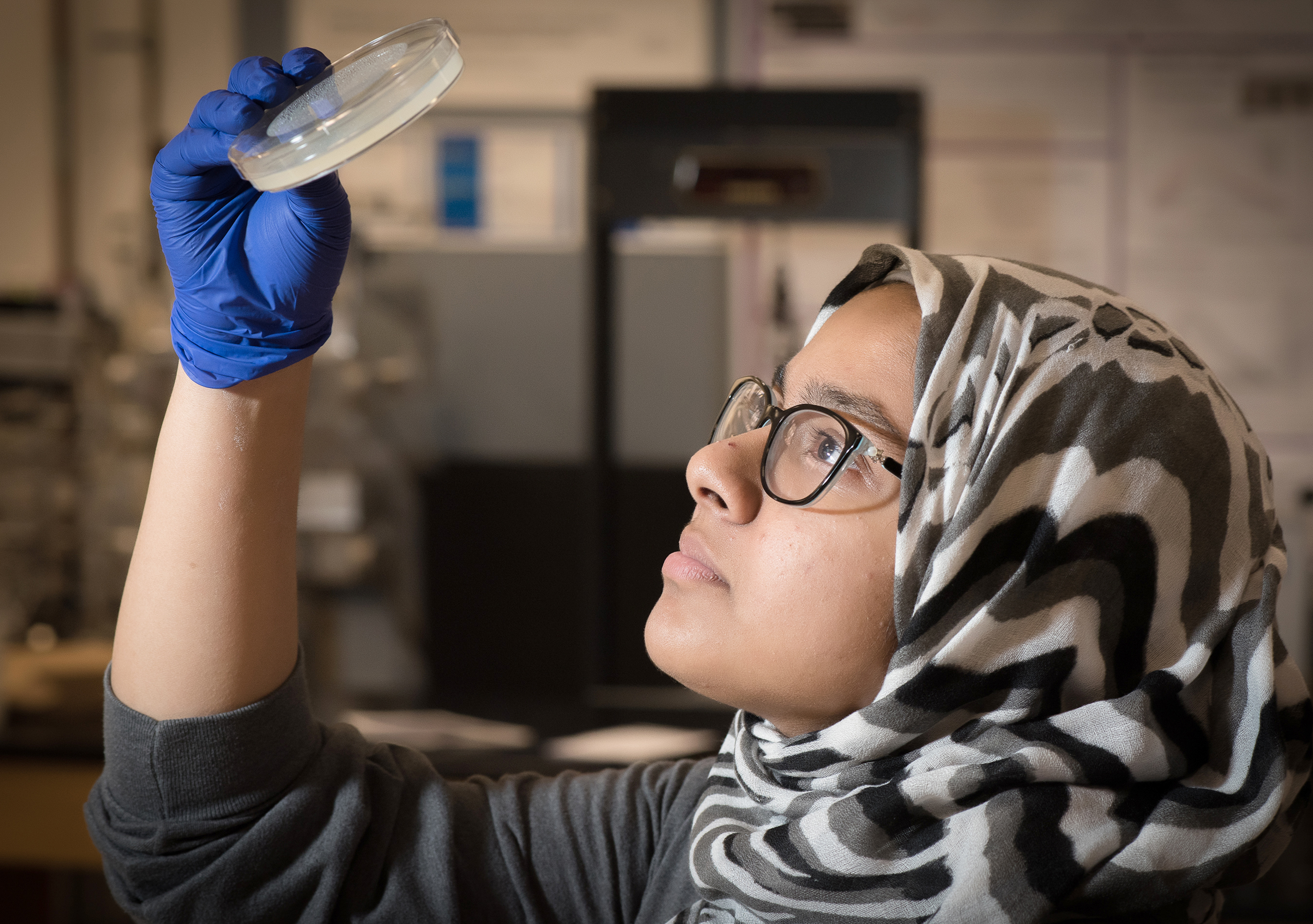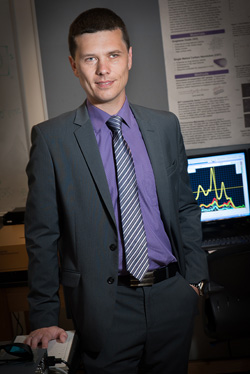Altering Antibiotics
Student in TCU high school program works on medicines of tomorrow.

Afeefah Khazi-Syed, a senior at Harmony School of Innovation in Fort Worth, examines a petri dish in a lab where she works under the tutelage of TCU professors Yuri Strzhemechny and Anton Naumov. Photo by Glen E. Ellman
Altering Antibiotics
Student in TCU high school program works on medicines of tomorrow.
Fascinated by medicine and eager to take part in her elementary school’s science fair, Afeefah Khazi-Syed designed a project on the health benefits of proper etiquette.
“My first science project was about how covering your mouth when you sneeze prevents the spread of germs,” said Khazi-Syed. “I had a balloon filled with confetti to mimic sneezing, and I would pop the balloon, and all the confetti would spread like how germs would be spreading.”
From that fifth-grade endeavor, the graduating high school senior has moved on to exploring silver nanoparticles and carbon nanotubes in a program at TCU.
With a zeal to develop medicines to fight dangerous bacteria such as E. coli, Khazi-Syed has worked under the guidance of two professors participating in TCU’s Research Apprentices Program since 2015. The program in the College of Science & Engineering matches talented high school students with professors in physics, astronomy and chemistry.
Khazi-Syed first worked under Yuri Strzhemechny, associate professor and chair of physics and astronomy, and later with Anton Naumov, assistant professor of physics.
“The most important thing [working in a lab] has taught me is that research requires a lot of patience,” said Khazi-Syed, a student at Harmony School of Innovation in Fort Worth. “I knew that it would take a lot of work, but I didn’t realize it would take a lot of sitting around and waiting for things to happen.”
A Shine to Silver
Before joining Strzhemechny and later Naumov, Khazi-Syed worked with silver nanoparticles on her own after learning of their antibacterial properties. Intrigued by the silver nanoparticles’ potential benefit in medicine, she ordered nanomaterials from a science catalog to conduct independent investigations.
Silver is toxic to most organisms, proving the perfect inhibitor to many invasive diseases, so long as it can be pointed in the right direction. The silver nanoparticles that Khazi-Syed worked with were triangular prisms that, at about 20 to 40 nanometers along each side, were about 300,000 times thinner than a dime. The tiny nanomaterial can pass through a cell’s wall and attack the organisms.
Working at home and at the Harmony School’s lab, Khazi-Syed experimented with antibacterial properties through disc diffusion, which tests the effectiveness of an antibiotic. Disc diffusion involves loading a small disc about a third of the size of a dime with the nanoparticles, then placing the disc in the center of a petri dish with a particular strain of bacteria. The efficacy of the drug is measured by the width of the a ring of bacteria it destroys.
However, conducting these experiments at her high school proved difficult. Khazi-Syed said her school’s lab equipment and the lack of effective quarantining made cross-contamination a constant issue, often rendering her samples useless.
“I think it’s just exciting to be able to put together something that you can go out and share with the world.”
Afeefah Khazi-Syed
Turning to TCU
At Harmony School, physics teacher Nicole Turner noticed Khazi-Syed’s enthusiasm for scientific endeavors – and her frustration.
“Afeefah is one of my ideal students,” Turner said. “She’s hardworking; she’s independently motivated. When she has a question about something she doesn’t understand, she comes to me and we work it out.”
Given Khazi-Syed’s desire to research nanomaterials in greater depth, Turner told the young researcher about Strzhemechny’s research with silver nanoparticles. In short order, Khazi-Syed joined the apprentices program and began lab work under the professor’s guidance.
In 2005, Strzhemechny started TCU’s research program for high school students after participating in a similar one when he was a graduate student in physics at the City University of New York at Queens College. At that time, the New York teenagers worked alongside college students at the Garcia Center for Polymers at Engineered Interface in Stony Brook.
Strzhemechny said the New York program gave young, bright students the chance to learn more about the scientific process and to co-publish scientific articles. For graduate and undergraduate students, the program provided the help they needed to pursue larger projects as well as experience in teaching and guiding budding scientists.
Lighting Up the Lab
With access to a more advanced lab and other resources, Khazi-Syed created and tested her own silver nanoparticles. She learned about the significance of a nanoparticle’s size and shape and how, depending on its dimensions, the structure will resonate at different wavelengths on the electromagnetic spectrum. In other words, the silver nanoparticles become visible under an electron microscope.
“These resonances allow the nanoparticles to be used in numerous clinical and biological sensor applications as fluorescent probes,” said Strzhemechny.
Khazi-Syed also conducted experiments on improving the effectiveness of antibiotics against certain bacterial strains. Mixing silver nanoparticles with more traditional antibiotics, she tried the combination on cultures of E.coli and staphylococcus epidermidis, two bacterial strains that tend to become resistant to antibiotics.
Including the silver nanoparticles in the antibiotics improved the effectiveness of the drugs in Khazi-Syed’s experiments. That’s because, unlike most commercial antibiotics, silver nanoparticles attack several areas of the bacteria cell, making it more difficult for the cell to create an effective resistance.
With her silver nanoparticles investigations underway, Khazi-Syed created a research project for the 2016 Fort Worth Regional Science and Engineering Fair. Her research work, “Nano Is Novel: Improving Antibiotic Efficacy for S. epidermidis with Structurally Modified Silver Nanoparticles,” won first place in microbiology.
The same research presentation won a second place grand prize in life sciences at the Texas Science and Engineering Fair in San Antonio and placed third in the microbiology category in the Intel International Science and Engineering Fair 2016 in Phoenix.
Nanotubes Next
After working with Strzhemechny on silver nanoparticles, Khazi-Syed delved deeper into the world of medicinal nanostructures.

Anton Naumov, assistant professor of physics, guides the research endeavors of high school students who work in his lab. Photo by Glen E. Ellman
The apprentice researcher started working with Naumov in September to study the potential applications of carbon nanotubes, which are quasi-one-dimensional structures that are around 1 nanometer in diameter, That means they are so thin – 100,000 times thinner than a human hair –that they might as well be one-dimensional even though they are two- or three-dimensional.
And yet the nanotubes are many times stronger than tempered steel. Their size and strength make them the perfect matter for a new generation of medical electronics. They are able to absorb and retain drug molecules and transport them into cells for use.
Carbon nanotubes possess semiconducting properties, absorbing the energy from light and becoming fluorescent as a result. This trait allows scientists to track the progression of one or multiple drugs in biological tissue.
“If you are delivering a drug, you need to know where those drugs go,” Naumov said.
Tracking a drug with carbon nanotubes shows whether it is getting to the right place and infiltrating the right cells. “It’s like you’re making a map of the treatment’s path,” said Khazi-Syed.
Her research project, involving an antibiotic-resistant strain of staphylococcus, focuses on using carbon nanotubes to improve the effectiveness of existing antibiotics, as opposed to creating new antibiotics.
“The antibiotic we’re using is methicillin, and staph is known to be resistant to methicillin,” said Khazi-Syed. “So what we’re focusing on is using carbon nanotubes to carry methicillin to these staph cells to improve the treatment.”
The experiments so far have shown success, increasing the effectiveness of methicillin by 73 percent using carbon nanotubes as a vessel, Khazi-Syed said. “The fact that we’re able to take an existing antibiotic and improve it is very promising.”
With her carbon nanotube research going well, Khazi-Syed participated in the 2017 Fort Worth Regional Science and Engineering Fair at the University of Texas at Arlington. Her project, “Nano Today, Huge Tomorrow: Improving Antibiotic Drug Delivery for S. epidermidis Strains With a Novel CNT Dispersion,” won an honorable mention for best overall. She also plans to present the research results at the Intel International Science and Engineering Fair in Los Angeles in mid-May.
Additionally, with assistance from Naumov, Khazi-Syed is working to publish a scientific paper about their carbon nanotube research.
Promising Future
At Harmony School, Turner has noticed a difference in Khazi-Syed since she began working with the TCU professors in their research labs.
“She’s more organized about the data she’s collecting and about real-world applications where she’s able to make connections between her work and the real world,” said Turner. “And in class, she’s able to draw from those connections that she makes.”
Naumov is encouraged by Khazi-Syed’s research work and holds high hopes for her future. “Whatever field Afeefah decides to go into, they will surely benefit by having her,” he said.
After her high school graduation in May, Khazi-Syed will attend the Massachusetts Institute of Technology in Boston to pursue a career in biomedical engineering.
As for what the apprentice researcher learned from the professors at TCU, she said the experience taught her perseverance and patience. “I think it’s just exciting to be able to put together something that you can go out and share with the world,” she said.

Your comments are welcome
Comments
Related reading:
Features
TCU Partnerships Shape the Future of Medicine
Leadership programs at two Fort Worth hospitals take physicians into uncharted territory.
Features
Physicians Find Value in Leadership Programs
Do business and leadership belong in medical school?
Features
MBA Program Advances the Business of Health Care
The degree is intended for today’s leaders in a new health care environment.